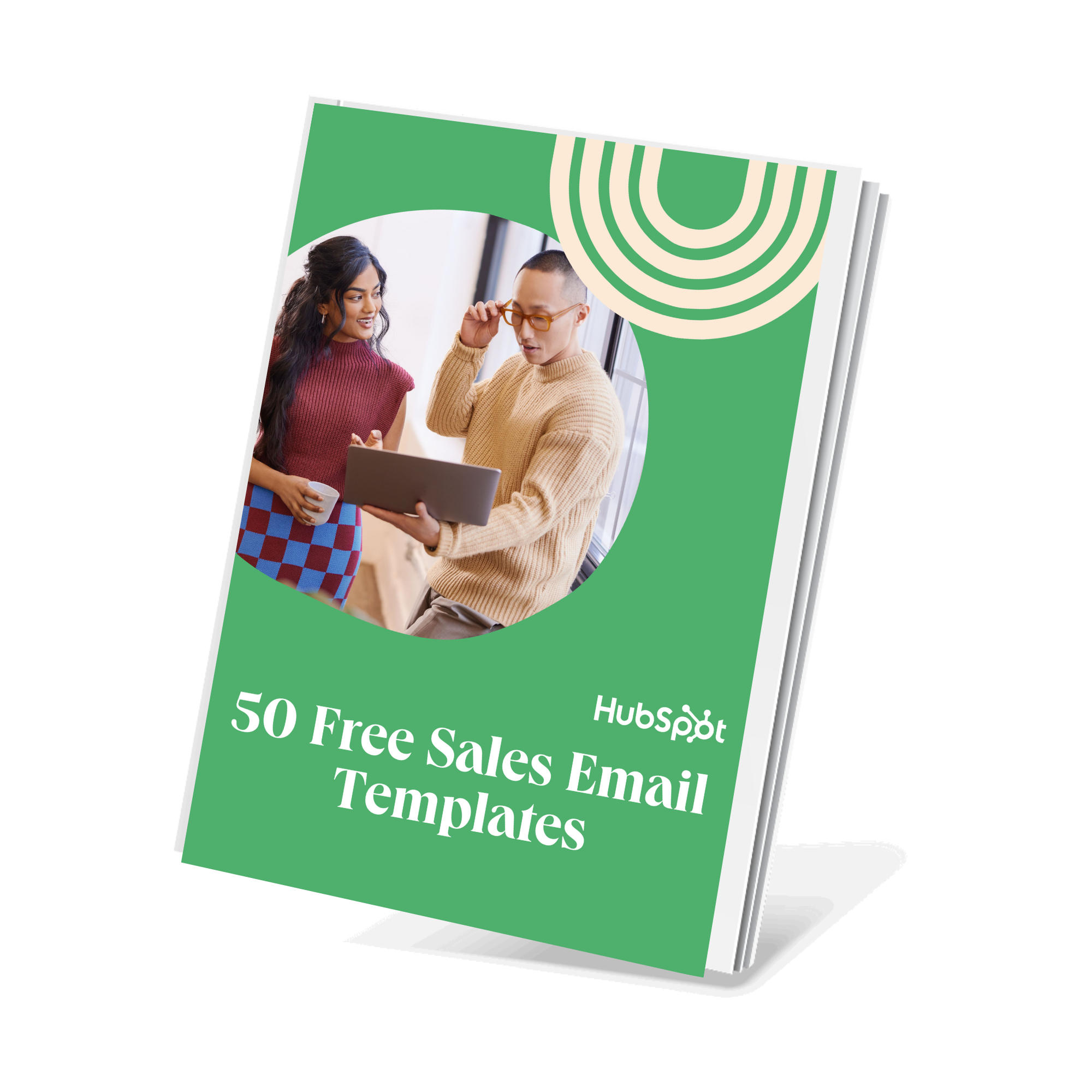Writing good sales emails is an art and a science, and good salespeople know how to write professional and personalized messages to prospects. No matter the tone or writing style you choose, your communication should be free of common sales email mistakes.
New sales reps have the opportunity to show their credibility in their sales emails. So as you begin your role, you should learn the best ways to communicate — and how you shouldn't. In this post, we'll share the biggest email mistakes that salespeople make so you can avoid them.
Common Email Mistakes
- Sending too many emails.
- Waiting too long to email prospects back.
- Giving up after one or two emails.
- Emailing the wrong person.
- Misspelling your prospect's name or company.
- Misspelling your company's name.
- Mistyping your cell phone number.
- Miscommunicating the date.
- Having a cluttered email signature.
- Writing out your entire sales pitch.
- Writing like a robot.
- Misspelling words.
- Misusing 'your' and 'you're' in sentences.
- Repeating words.
- Using inline lists instead of bullet points.
- Failing to format for better readability.
- Including too much information.
- Being way too vague.
- Burying your call to action.
- Not including a clear call to action.
- Including broken links.
- Copying and pasting without removing the previous formatting.

50 Free Sales Email Templates
Save time, find new ways to reach out to prospects, and send emails that actually convert.
- First-Touch Emails
- Follow-Up Emails
- Break-Up Emails
- ChatGPT Email Prompts
Download Free
All fields are required.

Email Mistakes at Work
1. Sending too many emails.
Brand-new reps often assume sales is a numbers game. To meet their quota, some will make the mistake of emailing as many prospects per day as possible.
But as seasoned salespeople know, the spray-and-pray approach doesn’t work. It prioritizes quantity over quality, so reps aren’t dedicating time to research buyers and personalize outreach. As a result, many won’t be a good fit.
Those who are probably won’t respond, as people are rarely compelled to answer non-personalized, generic messages. As a result, you might create a bad name for yourself and your company.
Pro Tip: Rather than sending out mass emails, focus on learning your organization’s buyer personas, conducting effective research, improving your prospecting skills, and writing personalized messages.
2. Waiting too long to email prospects back.
Some reps struggle with the opposite problem: Spending too long on every message. One new SDR recently told me she spends roughly 30 minutes researching each prospect before she emails them.
This level of preparation might be necessary for industries with limited numbers of buyers. However, most reps who spend this long on each email won’t hit the required activity level to meet their quota.
Strike a balance between too much research and needing more. At a minimum, you should look up the company’s recent announcements, browse its website, and check out the prospect’s social media profiles. However, you shouldn’t dive deep into your prospect’s blog or Twitter archives. If the relationship moves forward, you can do more homework — otherwise, it's not an efficient use of time.
3. Giving up after one or two emails.
Salespeople who have been around the block recognize the importance of following up. After all, 80% of sales require five touches to close — so if you don’t succeed at first, you should try, try again. However, 44% of salespeople give up after a single follow-up. New reps are likely to be in this camp. Silence from a prospect can feel like rejection if you don’t have much experience.
Once salespeople understand the difference between pushy and pleasantly persistent, they’re less likely to let a few unanswered emails stop them.
4. Emailing the wrong person.
You'd be surprised how many salespeople struggle with this mistake. Tessian research found that 40% of employees have emailed the wrong person. In that same study, almost 29% said their business lost a client or customer because of the error.
Double-check your tagged recipients before emailing your customers — especially if you're about to share confidential information.
5. Misspelling your prospect’s name or company.
Maybe you were tired when you sent the email. Maybe your eyes were blurry from staring at the screen for too long. Guess what? Your prospect won’t appreciate it. They’ll think you haven’t researched or aren't prioritizing their account. None of the above bode well for your ability to make the sale.
6. Misspelling your own company’s name.
Does this one even need an explanation? You're supposed to be the expert on your company and its product or service. Don't misspell the company's name.
7. Mistyping your phone number.
This is a mistake many salespeople learn about the hard way. If your email signature contains your mistyped phone number, that can be a big roadblock. A customer would have every right to be frustrated and wonder why you aren't picking up — or worse, disconnected.
If you’re going to provide a way for your prospects to get in touch, make sure it’s correct. If they take the initiative to call you, ensure it’s not wasting their time.
8. Miscommunicating the date.
Scheduling a meeting over email is supposed to be a reliable way to organize meetings with your prospect. If you ask them to meet on “Thursday, November 16th” when November 16th is actually a Wednesday, it creates confusion and necessitates an additional email to correct the mistake.
Pro Tip: Ensure you reference a calendar when including dates in your emails, or just share the invite via Google Calendar.
9. Having a cluttered email signature.
Simple, well-designed email signatures are few and far between, and they’re even rarer among new salespeople. One of the biggest mistakes new reps commit with their email signatures is choosing an obnoxious font, color scheme, image, or quote.
Pro Tip: Focus on the content of your email signature. And I get it — it's tempting to want to lean into a creative design. Still, you need a clean, professional email signature with critical information, such as:
- Cell phone number
- Links to social media profiles
- Region (if relevant)
Email Mistakes to Avoid
10. Writing out your entire sales pitch.
Crafting engaging, concise emails is an art even experienced reps struggle to master, so it’s not surprising new salespeople often struggle with it. Many fall into the trap of describing their product’s bells and whistles rather than focusing on their prospect’s challenges and objectives.
Buyers don’t typically respond well to sales pitches from strangers. You need to learn to write messages that speak to your prospect’s point of view to get responses.
11. Writing like a robot.
Novice reps often assume using five-dollar words and a formal tone will make them seem more intelligent and credible. But usually, this strategy makes salespeople sound stiff and unnatural, which doesn’t help them demonstrate their personality or put their prospects at ease. In addition, a study from Princeton University found that people who use overly complex words appear less intelligent.
Pro Tip: Be mindful of the industry your prospect works within. Unless they're in a conservative or traditional industry, you should try to sound more business casual. You want to show buyers that there’s an actual person on the other end.

50 Free Sales Email Templates
Save time, find new ways to reach out to prospects, and send emails that actually convert.
- First-Touch Emails
- Follow-Up Emails
- Break-Up Emails
- ChatGPT Email Prompts
Download Free
All fields are required.

12. Misspelling words.
According to Grammarly Business, 93% of business leaders acknowledge that effective communication is the backbone of business, yet ineffective communication costs businesses up to $1.2 trillion annually. Misspelled words are among people's most common email mistakes, and they can lead to misunderstandings.
Pro Tip: Use a tool that checks your spelling as you type to catch your errors without slowing down. Salespeople don't have all the time in the world to proofread, so you might as well use a free tool to help.
13. Misusing “your” and “you’re” in sentences.
Successful salespeople are intelligent, and an error like misusing homophones could leave a different message. It’s easy to slip up, but asking your prospect, “Do you have any time on you’re calendar to chat tomorrow?” can make you seem unprofessional.
Similarly, you should know the difference between “there,” “their,” and “they’re.” Writing "There excited about the new product," or "Their is no update yet" is another common grammar mistake that makes it harder for you to be taken seriously.
Misusing “its” and “it’s” is another commonly confused homophone. One's a possessive adjective, and the other is a contraction. Make sure to get it right before pressing send.
14. Repeating words.
Repeating words is another mistake that many salespeople overlook in their emails. That means accidentally typing the same words twice, for example:
"When will the report be be ready?"
While it's not the end of the world, your message will undoubtedly look cleaner without the doubles. And especially with grammar-checking tools, it would take only a moment to delete unnecessary words.
15. Using inline lists instead of bullet points.
Break out lists into easily scannable bulleted lists to make your prospect’s job even easier. Would you prefer to be asked if a meeting on "Monday at 3:00 PM, Tuesday at 12:00 PM, Tuesday at 1:45 PM, Wednesday at 9:00 a.m., Wednesday at 4 PM, or Thursday at 12:20 PM" or receive this email:
Let me know if any of the below times work for you:
- Monday at 3:00 PM
- Tuesday at 12:00 PM
- Tuesday at 1:45 PM
- Wednesday at 9:00 AM
- Wednesday at 4:00 PM
- Thursday at 12:30 PM
Do you prefer the second option? Yep, me too.
16. Failing to format for better readability.
You can accentuate important points during an in-person conversation using body language, voice tone, and gestures. It’s much harder to convey that type of tone in emails. If your email is longer than a paragraph and contains information your prospect must read, bold or italicize it to ensure it catches their eye.
Pro Tip: Don’t go too wild. An email where every other word is bolded or underlined is jarring to read and looks unprofessional.
17. Including too much information.
You want your emails to get to the point. If you’ve written 800 words but only felt the need to bold one statement, take a moment to check whether you need to include everything you’ve written. Save your prospect as much time as possible by cutting right to the point — they’ll appreciate it.
18. Being way too vague.
Vagueness isn't just irritating, it's inefficient. Your recipient has to work harder to understand what you're saying — and sometimes even ask for more information. Do your best to be specific. Rather than saying, "Are you interested in getting my thoughts on your strategy?" ask, "Do you want to spend 15 minutes reviewing your 2023 lead gen plans?"
19. Burying your call to action.
When addressing your prospect, you want to give them valuable information and a clear ask, next step, or variation of a call-to-action for them to complete afterward. And sometimes, you'll need to write a longer email. Pull your call to action into its own line or paragraph, so it’s not lost in the rest of the text.
20. Not including a clear call-to-action.
Whether it’s asking for 10 minutes to discuss resources you’ve just sent over or offering a product demonstration, every action you take should advance a prospect through the sales process if it’s a good fit.
Before you end your email with a signature, leave a clear message indicating what you'd like your customer to do in response to the information you've given them.
21. Including broken links.
Including a link or two in your sales emails is great when it's applicable. You're providing more content and an opportunity to click around your site and learn more about your product.
Ensure those links are updated and work, especially if you use a template. If your prospect is interested enough to click through, they deserve a good experience. After all, your prospect won't feel as supported if you include links that offer no help.
22. Copying and pasting without removing the previous formatting.
Have you ever gotten an email where a single section is much smaller than the others or appears in a different font? If so, you know how distracting it is. This weird issue is caused by copying and pasting without removing the formatting. To ensure this doesn't happen with your emails, highlight any sections you've pasted and click the "Remove Formatting" button in your email browser.
Pro Tip: If you're using Inbox or Gmail, you can remove formatting by highlighting a section and pressing Command + \ (the backward slash key). Outlook users, press Control + Space.

50 Free Sales Email Templates
Save time, find new ways to reach out to prospects, and send emails that actually convert.
- First-Touch Emails
- Follow-Up Emails
- Break-Up Emails
- ChatGPT Email Prompts
Download Free
All fields are required.

Why Do Email Mistakes Happen?
Tessian's 2022 Human Error Report shares that 52% of respondents are more likely to make work mistakes if stressed, while 43% say they are more error-prone when tired. Over a quarter of people will make mistakes when they feel burned out, and nearly half of the employees experience burnout to a certain degree.
Working in sales is tough, and it's important to recognize when you need to take a break, step away from your computer, and get well-needed rest. If you prioritize your well-being, email communication between you and your customers will become more concise.
Watch Out for These Sales Email Mistakes
While nothing beats personal experience, new reps can cut down on their learning curve by browsing sales email templates, checking out best practices, and asking veteran reps for feedback on their messages. The sooner salespeople begin crafting effective emails, the sooner they’ll start meeting quota.
Editor's Note: This article was originally published in October 2016 and has been updated for comprehensiveness.


![Download Now: 50 Sales Email Templates [Free Access]](https://no-cache.hubspot.com/cta/default/53/be67aa79-8dbe-4938-8256-fdf195247a9c.png)


.jpg)




